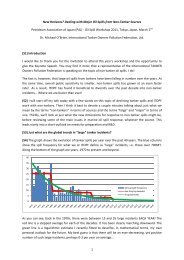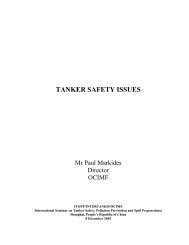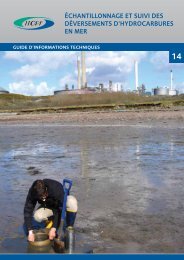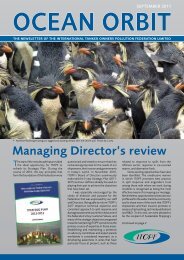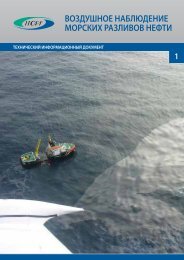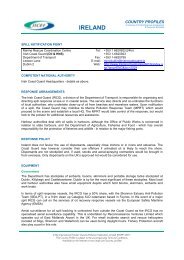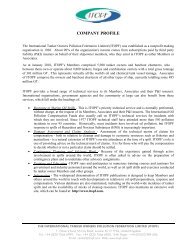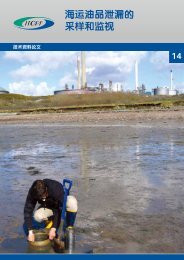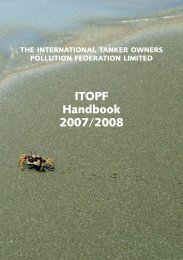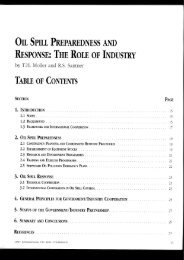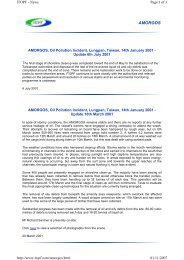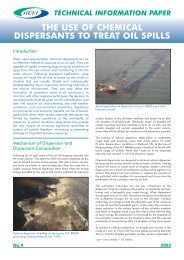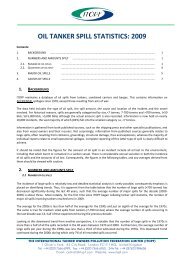Members Handbook 20023 - ITOPF
Members Handbook 20023 - ITOPF
Members Handbook 20023 - ITOPF
You also want an ePaper? Increase the reach of your titles
YUMPU automatically turns print PDFs into web optimized ePapers that Google loves.
single oiling. However, damage lasting<br />
many years can be inflicted by<br />
repeated oil spills or by aggressive<br />
clean-up activity, such as trampling or<br />
removal of oiled substrate.<br />
In tropical regions, mangrove swamps<br />
replace saltmarshes and provide an<br />
extremely rich and diverse habitat as<br />
well as coastal protection and important<br />
nursery areas. The mangrove trees<br />
which provide the framework upon<br />
which this habitat depends can<br />
sometimes be killed depending on the<br />
type of oil and the substrate in which the<br />
trees are growing. Damage is more likely<br />
if oil smothers their breathing roots or if<br />
toxic oils penetrate the sediments.<br />
Where high mortality of trees occurs, in<br />
some cases including trees which are 50<br />
or more years old, natural recovery to a<br />
diverse and productive structure can<br />
take decades. An important function of<br />
both saltmarsh and mangrove habitats is<br />
that they provide organic inputs to<br />
coastal waters which in turn enrich the<br />
communities living there. It is in these<br />
marsh and mangrove areas where<br />
damage has been recorded that<br />
reinstatement measures have real<br />
potential to speed up recovery.<br />
Restoration<br />
Removal of bulk oil contamination either<br />
through natural processes or a well<br />
conducted clean-up operation is the first<br />
stage of the recovery of a damaged<br />
environment. Thereafter it may be<br />
justified to take further active steps to<br />
restore lost resources and encourage<br />
natural recovery, especially in circumstances<br />
where it would otherwise be<br />
relatively slow. An example of such an<br />
approach following an oil spill would be to<br />
replant a saltmarsh or mangrove after the<br />
bulk oil contamination has been removed.<br />
In this way erosion of the area would be<br />
minimised and other forms of life would<br />
be encouraged to return.<br />
While it may be possible to help restore<br />
damaged vegetation and physical<br />
structures, designing meaningful<br />
restoration strategies for animals is a<br />
much greater challenge. In some cases it<br />
may be warranted to protect a natural<br />
breeding population at a nearby, unoiled,<br />
site, for example by predator<br />
control, to provide a reservoir from<br />
which re-colonisation of the damaged<br />
areas can occur. In reality, the<br />
complexity of the marine environment<br />
means that there are limits to which<br />
ecological damage can be repaired by<br />
artificial means. In most cases natural<br />
recovery is likely to be relatively rapid<br />
and will only rarely be outpaced by<br />
restoration measures.<br />
Economic Impacts<br />
Contamination of coastal amenity areas<br />
is a common feature of many oil spills,<br />
leading to interference with recreational<br />
activities such as bathing, boating,<br />
angling and diving. Hotel and restaurant<br />
owners and others who gain their<br />
livelihood from the tourist trade can also<br />
suffer temporary losses. A return to<br />
normal requires an effective clean-up<br />
programme and the restoration of<br />
public confidence.<br />
27



